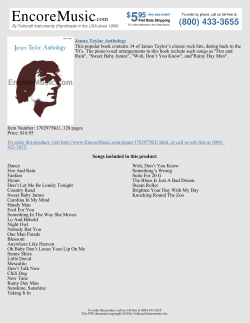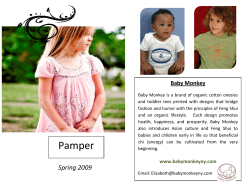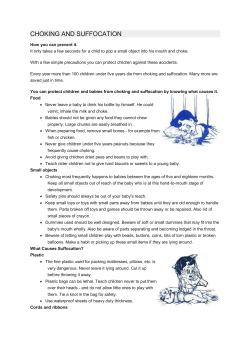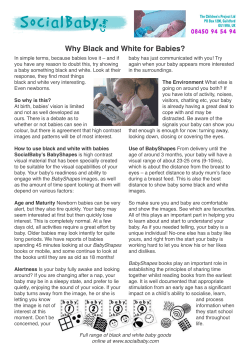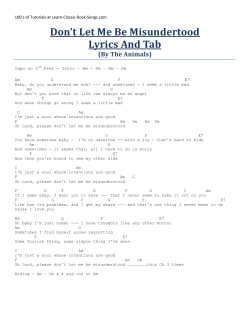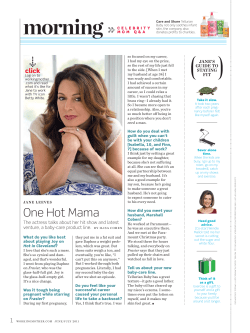
hildren earn rom atching
Month 6 6 Children Learn From Watching Parents When raising their children, many parents either do the things their own parents did, or they do just the opposite. What do you copy from your parents? What do you do that is different? Have you thought about why you copy some things and not others? Even though your baby is only 6 months old, he is learning by watching you. That is why it is so important to set a good example. Your baby will copy what family members do. Once set, patterns of family life are hard to change. Your baby will notice: How you talk to each other How you work out problems How you show your feelings Your Baby Is Half a Year Old! Now that your baby has reached the half-year mark, she is probably spending most of her awake time sitting up, playing, babbling, looking around, and touching everything. Your baby may be driving you a little crazy because she wants to grab everything she sees. Try to be patient; she is learning about the world. So far we have talked about how your baby grows each month. But another person has also grown— YOU. Congratulations—Keep up the good work! Talk to others with kindness and tell them what you really mean to say. Work out problems by talking about them and finding positive solutions. Show love and concern for family mem- Remember, you are the most important bers, but also tell them when you are an- influence in your children’s lives. How gry or upset so the issue can be resolved you act teaches them how to behave. before it becomes a big problem. What’s It Like to Be 6 Months Old? How I Grow and Talk I turn and twist in all directions. I roll from my back to my stomach. I sometimes can sit up without How I Respond How I Understand and Feel I pick up things, shake them, I know that I have to use my and then listen to the sound hands to pick up something. the support of my arms. I creep backward and forward with my stomach on the floor. I hold onto an object with one hand and then put it in the other hand. I hold one building block, reach for a second one, and look for a third one right away. I grab for an object when it drops. I still babble a lot, but I have more control of sounds. I’m beginning to understand some words by the tone of voice you use. they make when I drop them. I look at and study things for a I play games with people long time. I know. I turn objects upside down just I get upset when I’m around to get another view of them. grown-up strangers, but I’m friendly to children I don’t know. I turn when I hear my name. I coo, hum, or stop crying I haven’t learned how to con- sometimes when I hear music. trol my feelings yet. I keep very busy doing some- I complain and howl when I thing all the time. don’t get my way. I giggle, coo, and squeal with joy when I’m happy. I have very strong likes and dislikes about food. 2 Month 6 Discipline Is Teaching Six month old babies don’t understand what it means to obey you. Their minds are not developed enough for them to know right from wrong. However, they may do things that are not safe or things that you think are wrong. Pick your baby up and move her to safety if she For the next year or so, you need to help your is doing something dangerous. For example, take baby learn how to behave, which is sometimes her away from a stairway and put her in the mid- called discipline. Discipline really means teaching, dle of the room and say, “You can crawl here.” This not punishing. is redirecting. If you are a warm and loving parent, your baby will Remember to praise your baby for doing some- learn to trust you. The more your baby trusts you, the more she will accept the limits you put on her. She will want to do thing that is OK after you have Discipline really means teaching, not punishing. ignored misbehavior or redirected her. Baby proof your home so your the right thing to please you. baby has safe places to explore and move around. Research shows that discipline works best for For example, leave one low kitchen cabinet un- parents who have a warm relationship with their locked and stock it with safe plastic dishes. Have children. baby toys on low safe shelves that she can reach. Here are some good ways to teach your baby: Prevent problems before they happen. For exam- Let your baby know when she does things you like ple, put a safety gate on the stairs to prevent falls. with words, hugs, and smiles. The more positive Put a vase away or on a very high shelf out of your you are when your baby is good, the more baby’s reach. she will listen to you when you don’t like what she’s do- Make your baby’s world interesting. If she has fun ing. things to explore, she will be too busy having safe fun to get into trouble. For example, when you Ignore misbehavior, visit someone else’s home, take interesting toys such as spitting food, to hold her attention. This way she won’t get into if it’s not harming dangerous things at the other home. anyone. Don’t look at her, smile, or yell. Until Teach your baby to do things right. If she pulls the she stops, pretend you cat’s hair or yours, show her how to pat the cat or don’t see her. you gently. 3 When Your Doctor Says It Is Time to Start Solids Most doctors recommend that parents Use a small, narrow spoon. wait until their baby is 6 months old to Put a small amount of cereal toward start solid foods. Until that time, babies the middle of your baby’s tongue. can’t control their mouths and tongues If she seems interested, give her a very well so they may push food out of few more tastes with the spoon. If their mouths instead of eating it. she doesn’t like it, or pushes the spoon away, wait a few weeks and When you decide to feed your baby sol- try again. your baby has an allergy to rice cereal id food, choose the right moment. Try it when your baby is rested, when she is The first feedings will be messy. Your hungry but not starved, and when you baby has been used to sucking liquids. are relaxed. Now, she has to learn how to swallow solids. The tongue thrust that makes The first solid food to give your baby food come back out is a natural reaction. is often an iron- Your baby has to learn to swallow rather fortified cereal in than push her addition to breast tongue out. milk or infant formula. Choose The next a cereal foods after one cereals will baby with just ingredient such probably be a as just rice (least few teaspoons likely to cause of pureed veg- allergies), only oatmeal, or just etables or fruits. barley. Put a teaspoon of baby cereal But wait until your doctor tells you to in a dish and mix it with breast milk or give them a try. formula to a watery consistency. Don’t add sugar or salt or any other season- Try only one new food at a time. If you ing. For the first few weeks, offer the ce- start with a few teaspoons of infant rice real once or twice a day after the breast cereal, keep giving your baby just the or bottle feeding. rice cereal for a week or so. The reason you try only one food at a time is so you can see if your baby has a reaction to 4 4 a food or is allergic to it. So, see if before you start infant oatmeal or infant barley. Sometimes a new food can cause diarrhea, a skin rash, or even a runny nose. If you think your baby has an allergy problem, check with your doctor, nurse, or clinic. You can help your baby learn to eat healthy foods. Try to make eating a pleasant time. Babies Love Babies When you are around town, you will meet other parents with their babies. Notice how much the babies like to look at each other. Babies really do like other babies. Month 6 DO ’s and DON’T ’s of High Chair Safety DO always use the seat belt and strap. DO lock the tray into place. DO be sure your baby’s hands are out of the way when you lock the tray. Watch Out! High Chair Safety When your baby starts to lean forward out of his infant seat and you’re afraid he will tip over, it’s time for a high chair. Remember, though, babies can get badly hurt It should be sturdy, with a wide base so it won’t tip over. A seat belt with a crotch strap to go between your baby’s legs keeps him from sliding out and is a must. sharp edges to cut her or you. DO keep the high chair at in a high chair if you don’t follow safety rules. Here are some things to look for to be sure the high chair is safe for your baby: DO be sure that there are no least 12 inches away from The tray should lock securely on a table or counter. Your both sides and have no sharp baby could push off and edges. tip over. Belt buckles and tray locks should DO watch your baby closely. be easy for you to use but NOT Some babies have slipped easy for your baby to use. down between the leg straps and strangled. Caps or plugs on tubing should be firmly attached and unable to be pulled off. They could cause a child to choke. leave the chair DON’T near a stove. leave your baby DON’T Make a date to meet another parent and It should be easy to clean. If the baby at the park or at your home. Make finish will allow, you can place it a fun time. See what the babies will do the high chair in the shower stall with each other. to soak and steam it clean. It’s great to watch another parent and If the seat is slippery, attach rub- let other children DON’T baby together. You can learn a lot from ber bathtub adhesive stickers climb on the chair. just watching, and they can learn from to the seat so your baby doesn’t you, too. slide around. alone in the chair. DON’T let your baby stand in the chair. 5 Take Care of Baby Teeth Fathers Are Changing Baby teeth do five important things: Chew food Today, many fathers are quite in- Help child speak clearly volved in raising their children. These fathers play with their babies, feed Guide permanent teeth into place and change their babies, and create Add to general good health a warm close relationship with them. Make a nice smile More mothers work outside the home than in the past, so dads are taking on the responsibility of doing Tooth decay is a serious problem for Baby’s First Tooth young children. Half of American more in-home work, including caring for their children. By taking care of Some babies are born with one or their children each day, fathers have more teeth; others do not get teeth a chance to form a strong, close bond until after their first birthday. Be- with them. cause the average age for the first children have cavities by the time they are 2 years old. Cavities are caused when sugars in breast milk, formula, sweetened tooth is 7 months old, your baby Dads create that close bond drinks, and juices are on the baby’s may begin teething soon. teeth for long periods of time. This with their babies by giving them some special Your baby’s first teeth will probably time each day. By focus- come in easily. She may have slight- ing on just their baby often happens if a baby sleeps with a bottle in his mouth or stays attached to the breast and goes to sleep. ly inflamed gums, some drooling, and nothing else, and quite a bit of chewing dads are telling as the first teeth come through. To comfort your may be fussy. Teething does not cause that they baby, rub her gums with high fever above 101 degrees, vomit- are your clean finger or give ing, or diarrhea. If your baby has these her a cool safe teething symptoms, call your doctor. their children im- portant. ring she can chew. After teething, the first tooth is a wel- When teething, come sight. By the time your child is 2 your baby may to 3 years old, all 20 baby teeth should have a runny be in. Many people believe that if chil- nose or a rash dren lose their baby teeth, the teeth on her face and are not important. This is not true. See neck. She also the story above for reasons baby teeth must be protected. 6 Month 6 Games Babies Play Get What You Want: Using a Tool Game Purpose of game: Encourage your baby to use objects as tools for getting what he wants. Safety Alert for Parents and Caregivers: Childproof Your Home It’s time to childproof your home. Your your water heater down to 120 de- baby is getting around more now and grees. Lock up matches and lighters. can get into things that are danger- Put knives and sharp scissors out of ous. reach. Look everywhere for small items your Put medicines, cosmetics, cleaning baby could choke on and remove agents, and anything poisonous in a them. This may be hard if you have locked cabinet. Put safety gates at the older children who have toys with tiny top and the bottom of the stairs. parts, but it’s important. Make sure the paint and furniture in Remove things that could smother your house is nontoxic. Some of your your baby, like pillows and soft bed- furniture may have been painted with ding from the crib. Put plastic bags lead paint. Remove poisonous house- where your baby can’t reach them. plants. Consult the Consumer Product Safety Commission http://www.cpsc. Prevent burns by turning pot handles gov for more information to keep your toward the back of the stove. Turn baby from being accidentally poi- How to play: Put your baby in a sitting position on the floor with a small blanket in front of him. Make sure he can reach the blanket. Sit beside him. Put a favorite toy on the blanket, but place it out of reach. If your baby does not pull the blanket to get the toy, pull the blanket toward him until he can reach the toy. Use action words to describe what he is doing, such as “See, you got the ball by pulling the blanket.” You can use towels, potholders, or pillows instead of a blanket. Play the game with another toy to see if your baby learns to pull the blanket to get what he wants. Stop if he gets tired or fussy. soned. 7 Want to Learn More? It is common for babies who have been sleeping through the night to begin waking up at night. Reasons for this might be the baby wants to play; he might not feel well, or it may just be the development of a new sleep cycle and behavior. Unless your baby is in pain, it’s best for your baby to learn to comfort himself to get back to sleep. Leave him alone for a few minutes to see if this happens. If it doesn’t, comfort the baby and tell him it’s time to go to sleep. He may cry a little and that is OK. If the baby cries for more than 15 minutes, go back in to comfort him. For an online version of this newsletter go to www.extension.org and choose parenting. If you have questions, contact your local Extension office. When reading this newsletter, remember: Every baby is different. Children may do things earlier or later than described here. This newsletter gives equal space and time to both sexes. If he or she is used, we are talking about all babies. Credits: This newsletter was adapted from Extension Just In Time Parenting Newsletters in California, Delaware, Georgia, Iowa, Kentucky, Maine, Tennessee, Nevada, New Hampshire, New Mexico, and Wisconsin. Month 6 Your Baby May Wake at Night
© Copyright 2025

